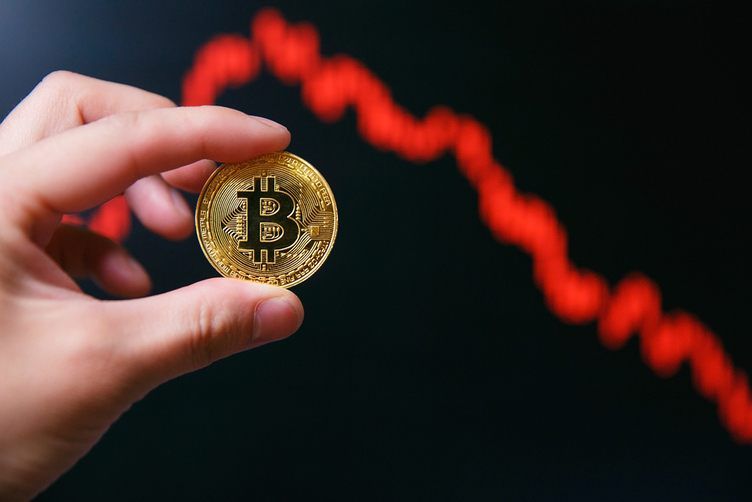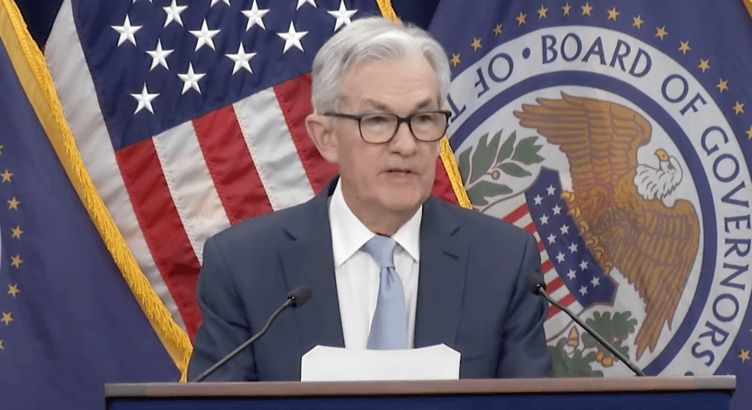Bitcoin in 2022: A Year to Forget

In November 2021, Bitcoin was above $68,000, its market capitalization was more than $1 trillion, and crypto's was $3 trillion.
As the year draws to a close, the price of Bitcoin is under $18,000, its market cap is one-third of a trillion, and the entire crypto market is worth $850 billion.
This is partly down to the state of the economy… well, everywhere. Inflation is at 40-year highs. The S&P 500 is down almost 17% and the Nasdaq 30%.
But Bitcoin has plunged by about 75% — and a pretty good chunk of that is self-inflicted. The collapse of the Terra/LUNA stablecoin ecosystem not only deleted $48 billion in value from crypto investors, it sent a wave of bankruptcies out across crypto lenders. They had been signing up millions of people and offering interest rates of up to 20%, while banks were delivering well under 1%.
Crypto didn't have a level drop. In three one-week periods, Bitcoin suffered huge collapses. In May, June and November.

May corresponds with the collapse of the UST stablecoin; June with the one-two punch of record inflation and the Fed's first triple-size 0.75 percentage point rate hike along with the collapsing crypto lenders; and November was all Sam Bankman-Fried, as world's second-largest crypto exchange, FTX, loaned $10 billion of its customers' fund to sister trading firm Alameda Research on the sly, which promptly lost $8 billion, imploding his empire.
January
January 1: $47,686.81 January 31: $38,483.13

When Bitcoin's 13th anniversary rolled around on the third of the month, BTC was in a fairly normal slump that didn't really have many serious supporters concerned.
Goldman Sachs was about to "become the latest investment bank to predict that Bitcoin has the potential to hit $100,000," and suggested it would "continue wrestling market share away from gold."
By the end of the week, the tone had begun to change. The Crypto Fear & Greed Index had hit 15, the Federal Reserve was tightening the money supply more aggressively, and crypto investment firm Galaxy Digital's Mike Novogratz suggested that BTC might dip below $40,000 — but only by a little bit — before bottoming out.
Meanwhile, concerns over unrest in Kazakhstan cutting into mining, the growing Omicron variant of COVID-19 and Elon Musk pulling back from selling Teslas for Bitcoin due to environmental issues were still big concerns as Bitcoin toyed with $40,000.
The faithful were still faithful as the month rolled on. Billionaire Bill Miller revealed that a staggering half his net worth was in Bitcoin — although he still said mere mortals should target 1% — Jack Dorsey was talking about making Bitcoin mining's profits more accessible to the masses, and Michael Saylor, then still CEO of Bitcoin mega-buyer MicroStrategy, was confident that Bitcoin remained the "best defense against inflation."
The Crypto Fear & Greed Index was back in the low to mid-20s — still extreme, but less so.
But the cracks were beginning to form. A Morgan Stanley survey found just 5% of its customers believed Bitcoin would cross $100,000 in 2022. Cathie Wood's Ark Invest was still talking about BTC surging past the $1 million range, but by 2030 — a long way off.
By the third week of the month, Bitcoin was now solidly below $40,000 and had dipped close to $33,000, crypto's market capitalization had fallen well below $2 trillion, and "risk assets" were getting hammered by the bond market.
As the month began grinding toward its end, there were 30,000 fewer Bitcoin millionaires than at November 2021's peak, the Fed made clear it was about to turn off the money tap with interest rate rises, and Bitcoin was officially having its worst January since 2018.
February
February 1: $38,743.27 February 28: $43,193.27

Bitcoin began the month by ramping back up into the low $40,000s — up 30% from its January dip, reaching briefly past $45,000 about a week-and-a-half in.
But it was becoming more and more clear that Bitcoin — and really, all of crypto — was joined at the hip to the stock market, which was looking a bit wobbly after a long bull market.
Tesla's high-profile $1.5 billion Bitcoin buy gave a good snapshot of the market: Down $100 million this year, Elon Musk was still $400 million in the black. Meanwhile, enough bullishness remained that KPMG Canada still felt that Bitcoin was a "maturing asset class" and that the "investment reflects our belief that institutional adoption of cryptoassets and blockchain technology will continue to grow and become a regular part of the asset mix."
Later in the month, Pantera Capital CEO Dan Morehead would predict (wrongly) Bitcoin and the stock market would be decoupling soon and that "blockchain is the best relative asset class in a rising rate environment." Digital assets, he added, would become more attractive as the Fed began increasing interest rates in March. But Huobi's Du Jun warned later in the month that another bull run would likely not come until late 2024 or even 2025.
El Salvador's President Nayib Bukele, meanwhile, was even more emphatically bullish — telling the International Monetary Fund (IMF) and then the U.S. Senate to "stay out of [El Salvador's] internal affairs." Of course without the billion-dollar IMF loan it had been negotiating, the country may face a bond default in 2023.
Then Ukraine tensions started hitting high gear, first knocking Bitcoin down to $40,000 as Russia's build-up grew, then back into the high $30,000s, cooling as Moscow recognized breakaway Ukrainian regions, and finally below $35,000 as Russia launched its ill-fated invasion.
Finally, the biggest crypto crime news was not the loss of crypto to hackers — a trend that would grow explosively throughout the year — but its return. The Department of Justice announced the arrest of Ilya Lichtenstein and Heather Morgan for the 2016 Bitfinex hack, along with the seizure of $3.6 billion worth of the $4.5 billion stolen.
March
March 1: $44,354.64 March 31: $45,538.68

Pretty much everything financial dropped after Russia heavily shelled a Ukrainian nuclear power plant, threatening a nuclear disaster in Europe "10 times larger than Chernobyl." Bitcoin was below $41,000.
Meanwhile, U.S. inflation was skyrocketing to 7.9% — four times the Fed's general target rate. The European Central Bank (ECB) said it was cutting off the money taps sooner than planned too. But surprisingly, Bitcoin stayed flat.
However, Bitcoin was under attack in Europe, where the European Parliament voted down an attempt to ban BTC and other cryptocurrencies using energy-intensive Proof-of-Work mining — technically requiring them to meet "minimum environmental sustainability standards" — under the forthcoming Markets in Crypto-Assets (MICA) regulations. It wouldn't be the last time that green MEPs would push that.
Fed Chairman Jerome Powell announced a 0.25 percentage point increase in the federal funds rate, leading to predictions that it would end the year between 1.75% and 2% — a pretty substantial lowball of its mid-December 3.83%. Inflation hit a 40-year high, with the Fed predicting it would cool to 4.3% by the end of the year — another lowball for its current 7.7%.
Back in El Salvador, where President Bukele's Bitcoin-as-legal-tender was and is popular with an increasingly tiny percentage of the population, a very silly push by American lawmakers to mandate a study on how the country's Bitcoin Law could impact the American economy led to an equally silly comment from Bukele that the U.S. was "afraid" of the Central American country's Bitcoin experiment.
Despite all of that, Bitcoin was strengthening by the end of the month, cracking $45,000 on March 27 and ending the month in the high $40,000s.
April
1 April: $46,281.64 30 April: $37,714.88

April started out with a fairly substantial drop from $46,000 down to the $39,000-$40,000 range in the first two weeks, but stayed pretty stable after that before creeping below $38,000 at the end of the month.
Worsening inflation, the war in Ukraine and talk of a steeper-than-expected 0.5 percentage point hike by Fed Chairman Powell all helped keep Bitcoin's head down. And yet, there were still signs of optimism: Morgan Stanley said wholesale banks could thrive when a regulated crypto market that Washington was paying more attention to finally emerged, and Fidelity announced plans to offer Bitcoin inclusion in its 401(k) accounts.
Terraform Labs' LUNA token surged 17% in just 24 hours in mid-April, allowing the peg-stabilizing arbitrage token to help push UST to the third-largest stablecoin, behind USDC and USDT.
Yet there were signs that were, with hindsight, ominous. The non-profit Luna Foundation Guard (LFG) announced that it was building a large warchest of Bitcoin worth billions to support UST's algorithmic peg to the dollar.
Meanwhile, despite dropping interest in El Salvador, a second country adopted Bitcoin as legal tender. But the tiny Central African Republic, in the midst of a long civil war, didn't add much luster. Panama didn't go as far, although it did legalize Bitcoin without adding a capital gains tax. Meanwhile, crypto-savvy Ukraine was getting a lot of support from the industry.
In America, another split was forming. While cities like Fort Worth in Texas were embracing mining, New York began a clampdown — one that would keep on growing — as environmentally unsound.
May
1 May: $38,469.09 31 May: $31,792.31
1 comment